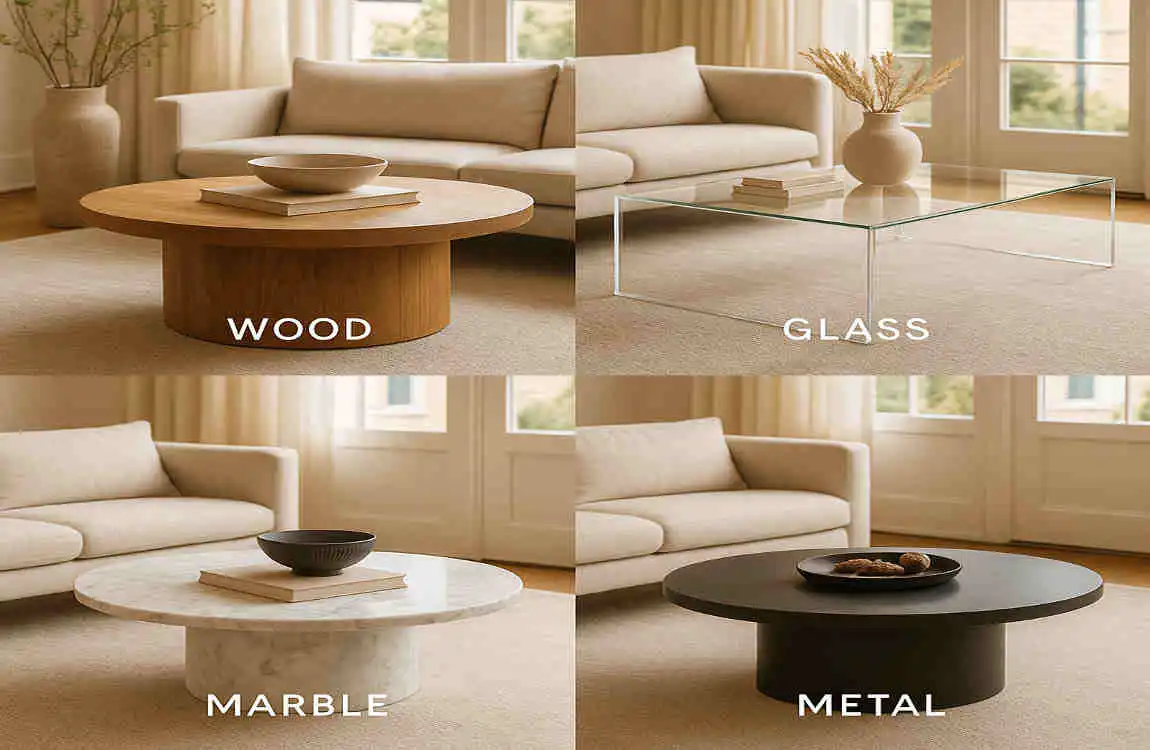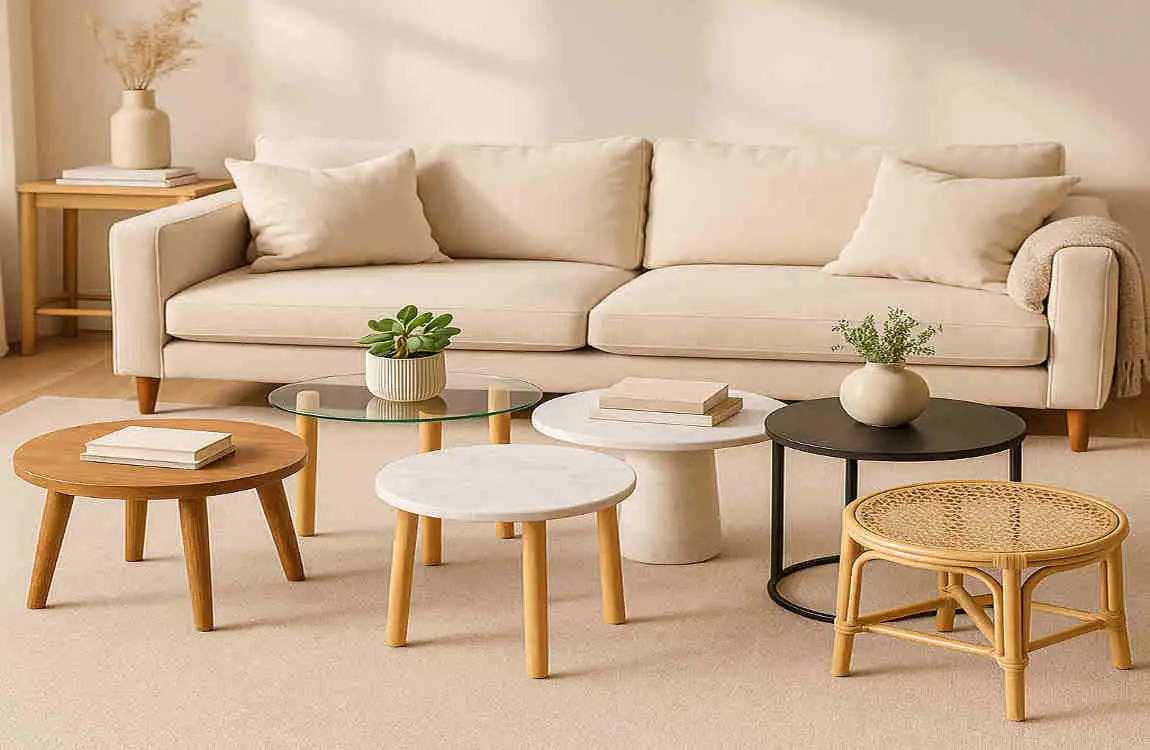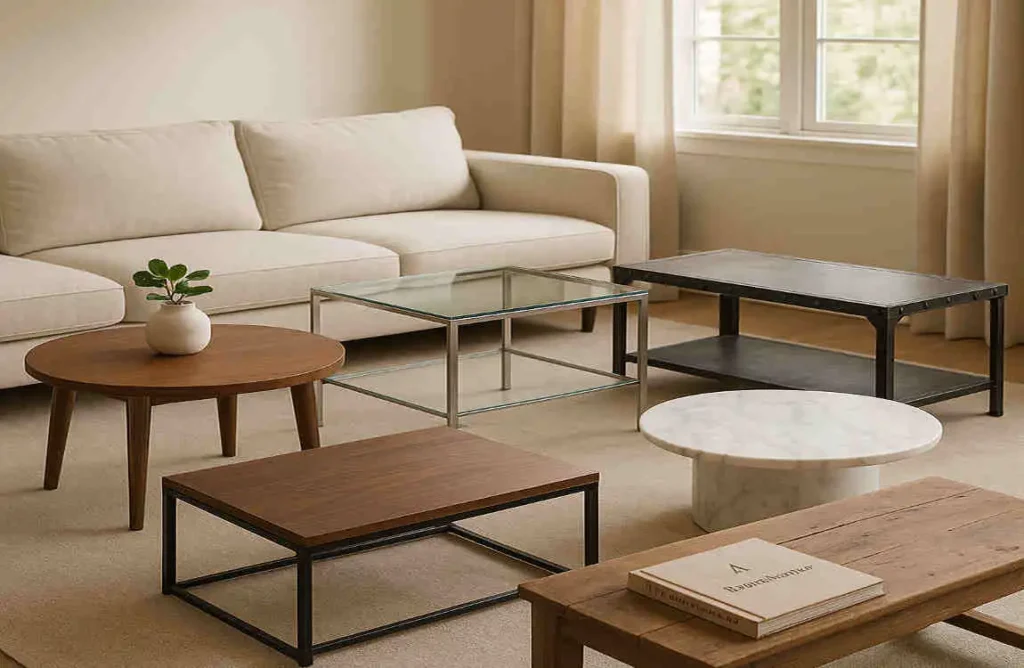Coffee tables are a central piece in any living room, serving both functional and decorative purposes. They provide a surface for placing drinks, books, and other items while also contributing to the overall style and aesthetics of the space. When choosing a coffee table, one of the most important factors to consider is the material it is made of.
Why Material Matters for Coffee Tables

The material of your coffee table can significantly impact its durability, lifespan, style, and maintenance requirements. Some materials are more resilient and can withstand daily wear and tear, while others may be more delicate and require careful handling. The material also plays a role in the overall aesthetic of your living room, complementing or contrasting with your existing home decor. Additionally, different materials come with varying price points, making budget a crucial consideration when selecting a coffee table.
Overview of Common Coffee Table Materials
Coffee tables are crafted from a wide range of materials, including both natural and synthetic options. Some of the most common materials include wood, metal, glass, stone, and composite materials. Each material has its unique characteristics, pros, and cons, making it suitable for different lifestyles and design preferences.
Wood Coffee Tables
Wood is a classic and versatile material for coffee tables. It can be used in various forms, such as solid wood, engineered wood, or reclaimed wood. Popular wood varieties for coffee tables include:
- Oak
- Walnut
- Pine
- Mahogany
- Maple
Pros of Wood Coffee Tables
- Durability: Wood is a sturdy material that can withstand daily use and last for years with proper care.
- Timeless Appeal: Wood boasts a timeless and warm aesthetic that complements a wide range of design styles.
- Versatility: Wood coffee tables are available in a range of finishes and stains, allowing you to customize the look to suit your personal preferences.
Cons of Wood Coffee Tables
- Cost: Solid wood coffee tables can be more expensive than those made from other materials.
- Susceptibility to Damage: Wood is prone to scratching and can be affected by water damage if not properly sealed or treated.
- Maintenance: Wood coffee tables require regular dusting and occasional polishing to maintain their appearance.
Wood coffee tables are best suited for homes with rustic, traditional, or modern farmhouse design styles.
Metal Coffee Tables
Metal coffee tables offer a sleek and contemporary look. Popular metals used for coffee tables include:
- Steel
- Aluminum
- Iron
- Brass
Pros of Metal Coffee Tables
- Durability: Metal is a strong and long-lasting material that can withstand heavy use.
- Industrial Look: Metal coffee tables contribute to an industrial or modern aesthetic.
- Lightweight Options: Some metal coffee tables, such as those made of aluminum, are lightweight and easy to move around.
Cons of Metal Coffee Tables
- Prone to Scratching: Metal surfaces can scratch easily if not treated with a protective finish.
- Rust Risks: Some metals, particularly iron, are susceptible to rust if exposed to moisture.
- Cold Feel: Metal coffee tables may feel cold to the touch, which can be less inviting to some people.
Metal coffee tables are commonly found in industrial, contemporary, and minimalist design styles.
Glass Coffee Tables
Glass coffee tables add a sense of elegance and lightness to a room. They are available in various types of glass, such as:
- Tempered glass
- Frosted glass
- Smoked glass
Pros of Glass Coffee Tables
- Visually Light: Glass coffee tables create an airy and open feel in a room.
- Easy to Clean: Glass surfaces are easy to wipe down and maintain.
- Modern Appeal: Glass coffee tables add a modern and sophisticated touch.
Cons of Glass Coffee Tables
- Fragility: Glass is a delicate material that can shatter or crack if subjected to heavy impact.
- Fingerprints and Smudges: Glass surfaces are prone to showing fingerprints and smudges, requiring frequent cleaning.
- Safety Concerns: Glass coffee tables may pose a safety risk, especially in homes with young children or pets.
Glass coffee tables are ideal for contemporary, minimalist, and modern living rooms.
Stone Coffee Tables
Stone coffee tables add a touch of luxury interior and natural beauty to a space. Popular stones used for coffee tables include:
- Marble
- Granite
- Quartz
Pros of Stone Coffee Tables
- Luxurious Look: Stone coffee tables have a high-end and sophisticated appearance.
- Heat Resistance: Stone surfaces are resistant to heat, making them suitable for placing hot dishes or beverages directly on them.
- Durability: Stone is a strong and long-lasting material that can withstand daily wear and tear.
Cons of Stone Coffee Tables
- Heavy Weight: Stone coffee tables are often heavy and difficult to move around.
- Expensive: Natural stone materials can be costly compared to other options.
- Maintenance: Stone surfaces require regular sealing and maintenance to prevent stains and etching.
To style a stone coffee table, consider pairing it with plush textiles, metallic accents, and greenery to balance its heavy look.
Composite and Laminated Materials
Composite and laminated materials are cost-effective alternatives to solid wood or stone. These include:
- Medium-density fiberboard (MDF)
- Particleboard with veneer
- Laminate finishes
Pros of Composite and Laminated Coffee Tables
- Affordability: Composite and laminated materials are generally more budget-friendly than solid wood or stone.
- Versatility: These materials can be produced in various designs and finishes to mimic the look of wood or stone.
- Easy to Produce: Composite and laminated coffee tables are mass-produced, making them readily available for purchase.
Cons of Composite and Laminated Coffee Tables
- Less Durability: Composite materials are less durable than solid wood or stone and may not withstand heavy use over time.
- Less Natural Look: Despite advancements in manufacturing, composite materials may lack the authentic look and feel of natural materials.
Composite and laminated coffee tables are suitable for buyers on a budget or those who frequently change their decor.
Other Unique and Emerging Materials
In addition to the standard materials mentioned above, there are some unique and emerging materials used for coffee tables:
- Acrylic and Plastic: These materials offer a modern and lightweight option, suitable for contemporary spaces.
- Bamboo and Rattan: Eco-friendly and sustainable, bamboo and rattan coffee tables add a natural and organic touch to a room.
- Concrete coffee tables offer a modern industrial vibe and are both durable and heat-resistant. However, they can be heavy and may require sealing to prevent stains.
How to Choose the Right Coffee Table Material for Your Home

When selecting a coffee table material, consider the following factors:
- Lifestyle Needs: If you have young children or pets, opt for durable materials that can withstand heavy use and potential scratches or spills.
- Existing Decor: Choose a material that complements your existing modern furniture and overall design style.
- Budget: Determine your budget and look for materials that offer the best value for your money.
- Maintenance Preferences: Consider the level of maintenance you are willing to undertake, such as regular dusting, polishing, or sealing.
Care and Maintenance Tips by Material
To keep your coffee table looking its best, follow these care and maintenance tips based on the material:
Wood
- Dust regularly with a soft, dry cloth.
- Use coasters to prevent water rings and stains.
- Polish occasionally with a wood-safe product to maintain the finish.
Metal
- Wipe with a damp cloth and dry thoroughly to prevent rust from forming.
- Use felt pads under decorative objects to avoid scratches.
- Apply a protective coating if necessary to prevent oxidation.
Glass
- Clean with a glass-safe cleaner and a soft, lint-free cloth.
- Use coasters to prevent water rings and scratches on your table.
- Avoid placing heavy or sharp objects on the glass surface.
Stone
- Wipe spills immediately to prevent staining.
- Use coasters and placemats to protect the surface.
- Seal the stone regularly to maintain its appearance and to avoid etching.
Composite Materials
- Dust regularly with a soft, dry cloth.
- Clean spills promptly to prevent staining.
- Avoid placing hot items directly on the surface to prevent damage.
